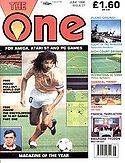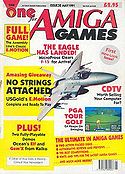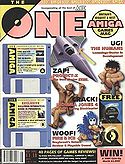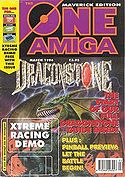.gif)
The One (magazine)
Encyclopedia
The One was a video game magazine in the United Kingdom
which covered 16-bit
home gaming during the late 1980s and early 1990s. It was first published by EMAP
in October 1988 and initially covered computer games aimed at the Atari ST
, Commodore Amiga, and IBM PC
markets.
Like many similar magazines, it contained sections of news, game reviews, previews, tips, help guides, columnist writings, readers' letters, and cover-mounted disks of game demos.
The magazine was sometimes criticised for including "filler" content such as articles on Arnold Schwarzenegger
with the justification that an upcoming film
had a computer game tie-in.
Readers also initially had trouble buying the magazine due to the name; The One lead to confusion among newsagents over exactly which magazine they meant.
and Atari
's ST
starting to gain more and more coverage in the multi format titles, EMAP decided it was time for a dedicated magazine to cater for these 16-bit super computers. The One for 16-Bit Games was launched and covered the Atari ST, Amiga, and PC
games market. Produced by editor Gary Penn
and a small team of contributors, the magazine went on to gain respectable circulation figures of over 40,000 readers.
 The industry voted The One for 16-Bit Games "Magazine of the Year" in February 1990.
The industry voted The One for 16-Bit Games "Magazine of the Year" in February 1990.
In June 1990, the magazine was extensively redesigned. Some regular features were dropped, the layout was changed, and the logo changed slightly to more emphasize ONE.
The ST and Amiga had reached new highs of success by 1991 and there were dozens of single format magazines taking advantage of this. Taking advantage of this trend EMAP, along with recently appointed editor Ciarán Brennan
, made the decision to split the magazine into The One for Amiga Games and The One for ST Games. PC games coverage was transferred to the recently launched PC Leisure
.
 1991 was the start of the 16-bit golden age. The 8-bit computers were in an irreversible decline and gamers were quickly moving over to the faster and more powerful 16-bit formats. Because many features fell into the general computing category, content remained similar between the two magazines. Because both magazines were produced by the same production team, the magazines had the same likeness, almost like twin magazines. However a few months later both titles would move in their own directions, catering for platform specific games.
1991 was the start of the 16-bit golden age. The 8-bit computers were in an irreversible decline and gamers were quickly moving over to the faster and more powerful 16-bit formats. Because many features fell into the general computing category, content remained similar between the two magazines. Because both magazines were produced by the same production team, the magazines had the same likeness, almost like twin magazines. However a few months later both titles would move in their own directions, catering for platform specific games.
In 1992 EMAP was shaking up their games magazines. Mean Machines
was split into two, The One for ST Games was incorporated into Europress
's ST Action
, and ACE
magazine closed. ACE magazine closing meant that there was a well-respected team available. To give the magazine a new direction and look, the original staff were moved and the ACE writers took their place. The change of The One was evident with magazines' relaunch. New editor, Jim Douglas, and his team produced the new magazine, with its shortened logo THE ONE, with the subtitle 'Incorporating all the best of ACE'. As the subtitle suggested, the magazine layout and content was essentially The One with some of the best content of ACE, all gelled together to produce an entirely new magazine.
 Just months after the redesign, most of the staff moved on and David Upchurch took over editorship. Again, the magazine gained the 'Amiga' onto its title. Now called The One Amiga, this would allow potential readers recognise the magazine as an Amiga title. The staples were also replaced in favour of a spine bound magazine.
Just months after the redesign, most of the staff moved on and David Upchurch took over editorship. Again, the magazine gained the 'Amiga' onto its title. Now called The One Amiga, this would allow potential readers recognise the magazine as an Amiga title. The staples were also replaced in favour of a spine bound magazine.
There were many significant changes to the Amiga market in 1993. More coverage was given to games that were A1200 specific and there was the launch of the CD32
. All formats were accommodated within the magazine by way of the details box which indicated what specification the game was designed for.
 In March 1994, David Upchurch announced that this would be his last issue. Deputy Editor, Simon Bryon, stepped up to replace him. Just eight issues later and the cycle repeated itself, Simon Byron left and, then Deputy Editor, Andy Nuttall replaced him. Despite the new editorship and optimism the magazine page count decreased to 84.
In March 1994, David Upchurch announced that this would be his last issue. Deputy Editor, Simon Bryon, stepped up to replace him. Just eight issues later and the cycle repeated itself, Simon Byron left and, then Deputy Editor, Andy Nuttall replaced him. Despite the new editorship and optimism the magazine page count decreased to 84.
July 1995 and it was announced that EMAP was closing the magazine down. The One content was incorporated into EMAP's other Amiga title, CU Amiga.
This wasn't the end of The One magazine as Maverick Magazines bought the title and launched their first edition in August 1995. However, it was obvious from the onset that this version, dubbed The One: Maverick Edition, was a slimmed down hybrid of a magazine. It looked like The One but it lacked the former writing style and spirit of the EMAP team. The magazine quickly decreased to a mere pamphlet style magazine of just 16 pages before dying off with the final issue of July 1996.
United Kingdom
The United Kingdom of Great Britain and Northern IrelandIn the United Kingdom and Dependencies, other languages have been officially recognised as legitimate autochthonous languages under the European Charter for Regional or Minority Languages...
which covered 16-bit
16-bit
-16-bit architecture:The HP BPC, introduced in 1975, was the world's first 16-bit microprocessor. Prominent 16-bit processors include the PDP-11, Intel 8086, Intel 80286 and the WDC 65C816. The Intel 8088 was program-compatible with the Intel 8086, and was 16-bit in that its registers were 16...
home gaming during the late 1980s and early 1990s. It was first published by EMAP
EMAP
Emap Limited is a British media company, specialising in the production of business-to-business magazines, and the organisation of business events and conferences...
in October 1988 and initially covered computer games aimed at the Atari ST
Atari ST
The Atari ST is a home/personal computer that was released by Atari Corporation in 1985 and commercially available from that summer into the early 1990s. The "ST" officially stands for "Sixteen/Thirty-two", which referred to the Motorola 68000's 16-bit external bus and 32-bit internals...
, Commodore Amiga, and IBM PC
IBM PC
The IBM Personal Computer, commonly known as the IBM PC, is the original version and progenitor of the IBM PC compatible hardware platform. It is IBM model number 5150, and was introduced on August 12, 1981...
markets.
Like many similar magazines, it contained sections of news, game reviews, previews, tips, help guides, columnist writings, readers' letters, and cover-mounted disks of game demos.
The magazine was sometimes criticised for including "filler" content such as articles on Arnold Schwarzenegger
Arnold Schwarzenegger
Arnold Alois Schwarzenegger is an Austrian-American former professional bodybuilder, actor, businessman, investor, and politician. Schwarzenegger served as the 38th Governor of California from 2003 until 2011....
with the justification that an upcoming film
Film
A film, also called a movie or motion picture, is a series of still or moving images. It is produced by recording photographic images with cameras, or by creating images using animation techniques or visual effects...
had a computer game tie-in.
Readers also initially had trouble buying the magazine due to the name; The One lead to confusion among newsagents over exactly which magazine they meant.
History
1988 and the 16-bit computer scene was beginning to emerge. With Commodore's AmigaAmiga
The Amiga is a family of personal computers that was sold by Commodore in the 1980s and 1990s. The first model was launched in 1985 as a high-end home computer and became popular for its graphical, audio and multi-tasking abilities...
and Atari
Atari
Atari is a corporate and brand name owned by several entities since its inception in 1972. It is currently owned by Atari Interactive, a wholly owned subsidiary of the French publisher Atari, SA . The original Atari, Inc. was founded in 1972 by Nolan Bushnell and Ted Dabney. It was a pioneer in...
's ST
Atari ST
The Atari ST is a home/personal computer that was released by Atari Corporation in 1985 and commercially available from that summer into the early 1990s. The "ST" officially stands for "Sixteen/Thirty-two", which referred to the Motorola 68000's 16-bit external bus and 32-bit internals...
starting to gain more and more coverage in the multi format titles, EMAP decided it was time for a dedicated magazine to cater for these 16-bit super computers. The One for 16-Bit Games was launched and covered the Atari ST, Amiga, and PC
Personal computer
A personal computer is any general-purpose computer whose size, capabilities, and original sales price make it useful for individuals, and which is intended to be operated directly by an end-user with no intervening computer operator...
games market. Produced by editor Gary Penn
Gary Penn
Gary Penn is a former British games reviewer who wrote for Zzap!64 in the '80s and is a games industry veteran. He later was editor of The One and was Creative Director at DMA Design where he supervised the release of the first Grand Theft Auto game in 1997....
and a small team of contributors, the magazine went on to gain respectable circulation figures of over 40,000 readers.

In June 1990, the magazine was extensively redesigned. Some regular features were dropped, the layout was changed, and the logo changed slightly to more emphasize ONE.
The ST and Amiga had reached new highs of success by 1991 and there were dozens of single format magazines taking advantage of this. Taking advantage of this trend EMAP, along with recently appointed editor Ciarán Brennan
Ciarán Brennan (journalist)
Ciarán Brennan is an Irish computer games journalist who was editor of the British computer games magazines Zzap!64 The One and PC Leisure in the late '80s and early '90s. He contributed to Computer and Video Games.-External links:...
, made the decision to split the magazine into The One for Amiga Games and The One for ST Games. PC games coverage was transferred to the recently launched PC Leisure
PC Leisure
PC Leisure was the United Kingdom's first magazine dedicated exclusively to IBM PC compatible entertainment and was published by EMAP between spring 1990 and September 1991. A total of nine issues were published in its lifetime, the first four being quarterly with the remaining five bimonthly...
.

In 1992 EMAP was shaking up their games magazines. Mean Machines
Mean Machines
Mean Machines was a market-leading multi-format gaming magazine released between 1990 and 1992 in the United Kingdom. Its style was popular with gamers of the time for its irreverent humor, anarchic editorial tone and style, and its sometimes outrageously outspoken reviews.- Origins :In the late...
was split into two, The One for ST Games was incorporated into Europress
Europress
Europress was a British magazine and software publisher. Their magazine publishing business was previously known as Database Publications.-History:...
's ST Action
ST Action
ST Action was a video game magazine published in the UK during the late 1980s and early 1990s that covered the Atari ST, platform. Some coverage was also given to the Atari Lynx and Atari Jaguar in the later stages of its life, although this was limited to the news section.ST Action was launched in...
, and ACE
ACE (games magazine)
ACE was a multi-format computer and video game magazine first published in the United Kingdom by Future Publishing and later acquired by EMAP.-History:...
magazine closed. ACE magazine closing meant that there was a well-respected team available. To give the magazine a new direction and look, the original staff were moved and the ACE writers took their place. The change of The One was evident with magazines' relaunch. New editor, Jim Douglas, and his team produced the new magazine, with its shortened logo THE ONE, with the subtitle 'Incorporating all the best of ACE'. As the subtitle suggested, the magazine layout and content was essentially The One with some of the best content of ACE, all gelled together to produce an entirely new magazine.

There were many significant changes to the Amiga market in 1993. More coverage was given to games that were A1200 specific and there was the launch of the CD32
CD32
CD32 is a surface receptor protein and part of a large population of B cell co-receptors, which act to modulate signaling.It has a low-affinity for IgG antibodies and down-regulates antibody production in the presence of IgG...
. All formats were accommodated within the magazine by way of the details box which indicated what specification the game was designed for.

July 1995 and it was announced that EMAP was closing the magazine down. The One content was incorporated into EMAP's other Amiga title, CU Amiga.
This wasn't the end of The One magazine as Maverick Magazines bought the title and launched their first edition in August 1995. However, it was obvious from the onset that this version, dubbed The One: Maverick Edition, was a slimmed down hybrid of a magazine. It looked like The One but it lacked the former writing style and spirit of the EMAP team. The magazine quickly decreased to a mere pamphlet style magazine of just 16 pages before dying off with the final issue of July 1996.
External links
- The Many Faces of The One - Amiga History Guide

